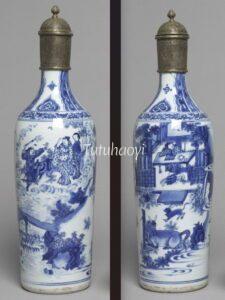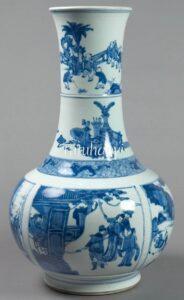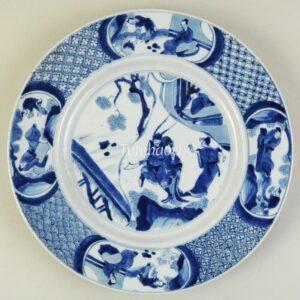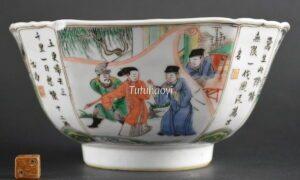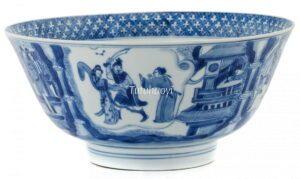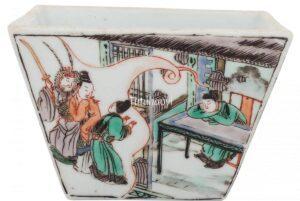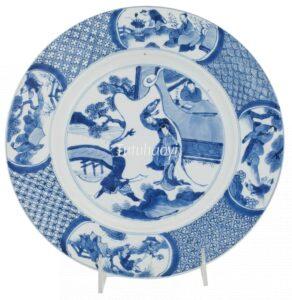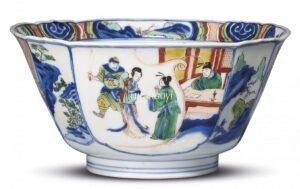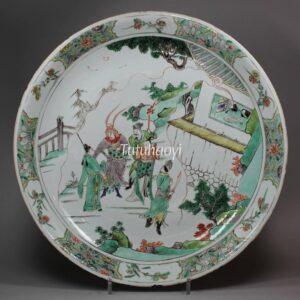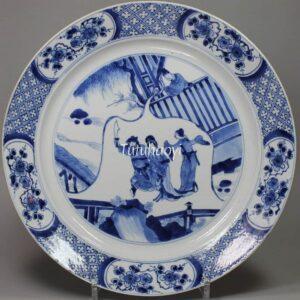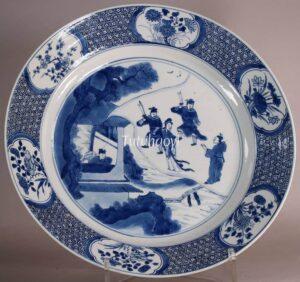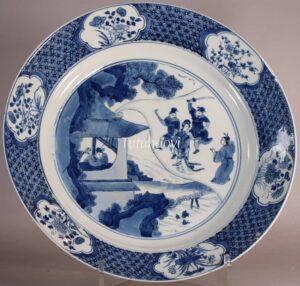Scholar Zhang’s startled dream at Caoqiao Inn
草桥惊梦
© Tutuhaoyi.com owns the copyright of the description content for the images attached. Quoting all or part of the description content on this page is permitted ONLY IF ‘Tutuhaoyi.com’ is clearly acknowledged anywhere your quote is produced unless stated otherwise. (本页描述内容版权归Tutuhaoyi.com所有,转发或引用需注明 “Tutuhaoyi.com”, 侵权必究, 已注开源信息的条目除外。)
This is Scene Four of Act Four of The Romance of the Western Chamber (Xixiang Ji 西厢记), a famous Chinese drama written by playwright Wang Shifu 王实甫 (1250–1336) in Yuan dynasty.
After parting with his lover Cui Yingying 崔莺莺 in Pudong district, Zhang Junrui (张君瑞, also called Scholar Zhang 张生) travels about twenty li toward the capital before stopping to rest at Caoqiao Inn (草桥店). Exhausted, he has no appetite for food and falls asleep.
Deeply troubled by the recent separation from Yingying, Scholar Zhang dreams of her immediately. In the dream, she braves the long and treacherous journey, crossing a river and a bridge, and eventually arrives at Caoqiao Inn to meet him. Scholar Zhang welcomes her, and the two pour out their feelings to each other.
As they speak, a bandit bursts forth from the shadows, torch in hand, demanding the woman who has just crossed the river. Scholar Zhang, unflinching in the face of danger, rebukes the intruder with fierce words. Yet the bandit still seizes Yingying and carries her away.
Startled awake from this harrowing dream, Scholar Zhang pushes open the door. Outside, a shroud of mist fills the air, frost glitters across the ground, the morning stars faintly flicker, and a waning crescent moon lingers in the sky. With a heavy heart, he sighs, ‘A dream of love, and yet it fades unfulfilled.’
story scene description by Rachel Ma
Other episodes in the Romance of the Western Chamber:
Consummation of love from Western Chamber 月下佳期
Scholar Zhang getting drunk due to Madame Cui’s broken promise 张生醉酒 (崔母悔婚)
Yingying Listening to the Qin Zither Playing 莺莺听琴 (琴心写恨)
Farewell feast at the pavilion 长亭送别 (哭宴)
Fig 1: porcelain vase with underglaze blue decoration, Chongzhen period (1628–44), Ming dynasty, courtesy of the Victoria & Albert Museum, London
Fig 2: porcelain vase with underglaze blue decoration, Kangxi period (1662–1722), Qing dynasty, courtesy of the Metropolitan Museum of Art, New York
Fig 3: porcelain dish with underglaze blue decoration, Kangxi period (1662–1722), Qing dynasty, courtesy of Penn Museum, Philadelphia
Fig 4: famille verte porcelain bowl, Kangxi period (1662–1722), Qing dynasty, courtesy of the Robert McPherson Antiques, UK, archived
Fig 5: porcelain bowl with underglaze blue decoration, Kangxi period (1662–1722), Qing dynasty, courtesy of the Jie Rui Tang Collection
Fig 6: famille verte porcelain bowl, Kangxi period (1662–1722), Qing dynasty, courtesy of the Jie Rui Tang Collection
Fig 7: porcelain dish with underglaze blue decoration, Kangxi period (1662–1722), Qing dynasty, courtesy of the Jie Rui Tang Collection
Fig 8: famille verte octagonal bowl, Kangxi period (1662–1722), Qing dynasty, courtesy of the Christie’s Auction House, Hong Kong, 3 Jun 2015, Lot 3227
Fig 9: famille verte porcelain dish, Kangxi period (1662–1722), Qing dynasty, courtesy of Guest & Gray Antique Dealer, London, archived, Ref: Y499
Fig 10: porcelain dish with underglaze blue decoration, Kangxi period (1662–1722), Qing dynasty, courtesy of Guest & Gray Antique Dealer, London, archived, Ref: Y265
Fig 11-12: two porcelain dishes with underglaze blue decoration, Kangxi period (1662–1722), Qing dynasty, courtesy of Guest & Gray Antique Dealer, London, archived, Ref: W683 and W684
